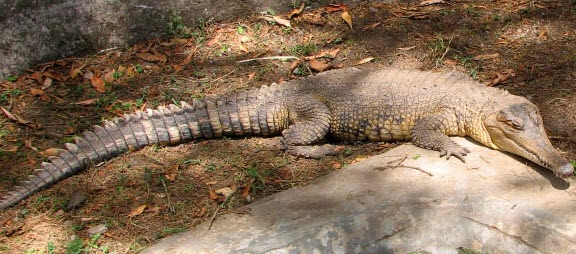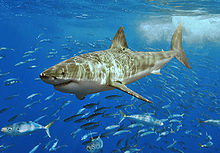Category Archives: Environmental
Two species of African Slender-Snouted Crocodile – Mecistops cataphractus

Image credit: Leyo
An international team of researchers from the University of Florida and the SFM Safari Gabon have through DNA Testing discovered that the African Slender-Snouted Crocodile ( Mecistops cataphractus) is actually two different species. Continue reading
Radioactive strontium-90 found in fish in Vermont, USA
Vermont health officials have found radioactive strontium-90 in a smallmouth bass taken from the Connecticut River.
Will grey seals counteract cod recovery in the Baltic Sea?
Grey seals and cod used to be found in great abundance throughout the Baltic Sea, but today the seals are chiefly present in the northern parts of the sea while the cod is found in the south.
China Releases 1.3 Billion Fish into Yangtze River
Last week, 1.3 billion fish were released into the Yangtze River by the Chinese Ministry of Agriculture (MOA). The release took place in the provinces of Jiangxi, Hubei, Hunan, Anhui and Jiangsu in the middle and lower reaches of the river.
Will a third force field be enough to protect the Great Lakes?
The U.S. Army Corps of Engineers have constructed an electric barrier in the Chicago Sanitary and Ship Canal, a waterway linking the Mississippi River with the Great Lakes watershed. The idea is to prevent Asian carps from entering the Great Lakes where it could wreck havoc with the ecosystem.
Seven species of carps native to Asia have been introduced to the United States, and four of them are considered a threat to the Great Lakes: bighead carp, silver carp, black carp and grass carp.
The new electric barrier is located slightly upstream from two similar barriers in the canal, and consists of underwater electrodes that creates a forced field by emitting rapid pulses. The force field is meant to repel fish and is capable of shocking those that refuse to turn around.
“We now have great flexibility and redundancy”, says Col. Vincent Quarles, commander of the Army Corps’ Chicago district. “We want to deter the Asian carp threat. The barrier is a very good tool.”
Since the early 1970s, Bighead carp and Silver carp have migrated northward on the Mississippi and its tributaries. Environmental groups have called for physically severing the man-made Chicago Sanitary and Ship Canal, which was completed in the year 1900 to connect the Great Lakes with the Mississippi drainage basins.
Michigan and four other Great Lakes states also wish to sever the canal, and there is currently a federal lawsuit pending against the Army Corps. The Army Corps have pledged to consider that option in a comprehensive study, but that study is not scheduled for completion until 2015.
The first electrical underwater fence in the Chicago Sanitary and Ship Canal was activated in 2002, while the second one was turned on seven years later. Federal and state officials say that the barriers have performed well, but skeptics keep questioning the effectiveness of the barriers. Scientists with the University of Notre Dame and The Nature Conservancy have reported findings of DNA from both Bighead carp and Silver carp in numerous locations above the barriers. However, no Asian carps have been found, save for one single specimen.
“There are still serious gaps in our knowledge about how well it’s working,” says Thom Cmar, an attorney with the Natural Resources Defense Council. “No one ever imagined these electric barriers would be a permanent solution. They’ve always been just a stopgap idea.”
In a newly released report, the Army Corps acknowledges that the 2 volts per inch used in the barriers may not be enough to deter small fish that are just a few inches in length. Increasing the voltage might however endanger the ships moving flammable items across the canal.
First census finds fewer White Sharks than expected in northeast Pacific Ocean
A team of researchers headed by Taylor Chapple, a UC Davis doctoral student, has made the first rigorous scientific estimate of White shark (Carcharodon carcharias) numbers in the northeast Pacific Ocean.
The researchers used small boats to reach spots in the Pacific Ocean where white whales congregate and lured them into photo range with a fake seal attached to a fishing line. Out of all the photographs taken, 321 photos showed dorsal fin edges. The dorsal fin edges of white sharks are jagged and each individual displays its own unique pattern. The photographs could therefore be used to identify individual sharks – 131 in total.
The research team then entered this information into statistical models to estimate the number of sharks in the region. According to their estimate, there are 219 adult* and sub-adult** white sharks in this area.
“This low number was a real surprise,” says Chapple. “It’s lower than we expected, and also substantially smaller than populations of other large marine predators, such as killer whales and polar bears. However, this estimate only represents a single point in time; further research will tell us if this number represents a healthy, viable population, or one critically in danger of collapse, or something in-between.”
The white shark population in the northeast Pacific Ocean is one of three known white shark populations in the world; the other two are found off the coast of South Africa and off Australia/New Zealand, respectively.
Earlier studies using satellite tagging have shown that the white sharks of the northeast Pacific Ocean have an annual migration pattern. Each year, they move from the region off the coast of central California and Mexico’s Guadalupe Island to the Hawaiian Islands or to an area of open ocean located between the Baja Peninsula and Hawaii. The latter destination has even been dubbed “White Shark Café” due to its popularity among white sharks. After spending some time away from the mainland, the sharks journey back to coastal waters.
“We’ve found that these white sharks return to the same regions of the coast year after year,” says Barbara Block, marine biologist at Stanford University and one of the co-authors of the pioneering white shark census. “It is this fact that makes it possible to estimate their numbers. Our goal is to keep track of our ocean predators.”
The paper “A first estimate of white shark, Carcharodon carcharias, abundance off Central California” (http://dx.doi.org/10.1098/rsbl.2011.0124) has been published in the journal Biology Letters (http://rsbl.royalsocietypublishing.org).
* Adult white sharks are the ones that have reached sexual maturity, something which happens when the male is roughly 13 feet and the female is about 15 feet in length.
**Sub-adults are roughly 8 feet or longer (but has not reached sexual maturity); at this size their dietary focus shifts from mostly fish to mostly marine mammals.
Study co-authors
- Taylor K. Chapple, Wildlife, Fish and Conservation Biology, University of California Davis, USA and Max Planck Institute, Germanyhttp://www.topp.org/user/taylorchapple
- Salvador J. Jorgensen, Hopkins Marine Station of Stanford University, USA and Monterey Bay Aquarium, USAhttp://www.topp.org/blog/salvo
- Scot D. Anderson, Point Reyes National Seashore, USA
- Paul E. Kanive, Department of Ecology, Montana State University, USA
- A. Peter Klimley, Wildlife, Fish and Conservation Biology, University of California Davis, USAhttp://wfcb.ucdavis.edu/people/faculty/klimley.php
- Louis W. Botsford, Wildlife, Fish and Conservation Biology, University of California Davis, USAhttp://wfcb.ucdavis.edu/people/faculty/botsford.php
- Barbara A. Block, Hopkins Marine Station of Stanford University, USAhttp://www-marine.stanford.edu/block.htm
Funding
- The National Oceanic and Atmospheric Association (NOAA) Fisheries through the Partnership for Education in Marine Resource and Ecosystem Management (PEMREM) and the NOAA Fisheries/Sea Grant Fellowship Program
- The Gordon and Betty Moore Foundation
- The National Parks Service’s Pacific Coast Science and Learning Center
- Monterey Bay Aquarium
- UC Davis Bodega Marine Laboratory
- Patricia King, member of the Point Reyes National Seashore Association
Are you an “off the beaten path” kind of traveler?
For those who wish to boldly go where just a handful of researchers has gone before, the Algalita Marine Research Foundation is now offering tickets to visit the Great Pacific Garbage Gyre.
In collaboration with Pangaea Explorations, a team of Algalita researchers will embark on a three week long scientific voyage through the Pacific Trash Vortex, a gyre of marine litter located roughly between 135° to 155°W to 42°N.
“We’ll be looking for changes in the accumulation of plastic in the North Pacific Gyre,” says Marcus Eriksen, who will lead the expedition’s research as Algalita’s Director of Project Development. “We suspect there’s greater accumulation, which means more harm to sea life and potentially to humans.”
The cost of each ticket is $10 000, and the net proceeds will be used to fund Algalita’s scientific research and educational outreach.
And even though you’re coughing up $10 000 for your fare, don’t expect a leisure cruise. The Sea Dragon, Pangaea’s 72-foot racing sloop, only have enough room for 14 people, including 4 professional crew members, and guests will be expected to help sail and maintain the vessel, stand watch during the night and cook up some hearty meals in the galley. To be considered for a spot on the Sea Dragon you must be fit enough to pull lines, raise sails and lift 1/3 of your weight. You must also be willing to get some very hands-on experience from garbage sorting.
“On this voyage, you’ll earn your sea legs and rough hands hauling in lines and hoisting sails, but you’ll also be “doing the science” side-by-side with researchers,” says Eriksen. “You’ll need to be fit as you prepare to trawl the sea, sort plastic, preserve samples and catalog it all.”
The ship leaves Hawaii on July 7 2011 and is expected to land in Vancouver on July 27.
To find out more and purchase your ticket, go to http://www.algalita.org/research/NorthPacificGyreVoyage.html
International consortium formed to study fertilizing oceans with iron
An international consortium has been formed to study the potential effects of adding iron to the ocean to promote the growth of phytoplankton. Phytoplankton use carbon dioxide from the atmosphere and ocean fertilization might therefore be a way of mitigating the effects of global warming. When phytoplankton die, organic carbon sinks to the seafloor where it may remain for decades, centuries or even longer – we still do not now much about the time-line.
Iron fertilization of the ocean is far from uncontroversial, since it is very difficult to foresee the long term effects of such a project. The international consortium, which has been named In-Situ Iron Studies (ISIS) consortium , will carry out iron fertilization experiments in the open ocean in an effort in to answer some of the questions regarding how iron affects the ocean’s capacity for dragging carbon dioxide from the air and into the water. All experiments will adhere to the London Convention/London Protocol regarding ocean iron fertilization research.
“A great deal remains to be learned about ocean iron fertilization and how effective it could be in storing carbon dioxide in the oceans, and the formation of this consortium is an important first step,” says Lewis Rothstein, professor of oceanography at the University of Rhode Island. “This is not a call for climate engineering; on the contrary this is a research consortium. It is premature to advocate for large-scale ocean iron fertilization, but it is time to conduct a focused research experiment that will examine the concept as comprehensively as we can. We want to make sure that it doesn’t generate harmful side effects that might negatively affect the marine ecosystem.”
The twelve ISIS-members are the following:
University of Rhode Island, USA
University of Hawaii, USA
University of Illinois at Urbana-Champaign, USA
University of Maine, USA
University of Massachusetts Boston, USA
University of Plymouth, UK
Xiamen University, Fujian, China
The Antarctic Climate and Ecosystems Cooperative Research Centre, Australia
Netherlands Institute for Sea Research, The Netherlands
The National Oceanography Centre, UK
Moss Landing Marine Laboratories, California, USA
Woods Hole Oceanographic Institution, Massachusetts, USA
African Wolf – New wolf Species discovered
This is not really fish related but cool enough to warrant a post here anyway. Scientists have discovered a new species of Wolf in Egypt. A team a researchers from Oxford University’s Wildlife Conservation Research Unit (WildCRU), the University of Oslo, and Addis Ababa University, with funding from the University of Oslo, shows that Gray wolves reached Africa around 3 million years ago before spreading throughout the northern hemisphere. The new wolf is a relative of the Holarctic grey wolf, the Indian wolf and the Himalayan wolf.
The Egyptian jackal (Canis aureus lupaster) is an importan part of the Egyptian mythology and has until now been considered a subspecies of the Golden jackal (Canis aureus) but this new research show that the egyptian jackal is infact a species of wolf. This new species is not closely related to the rare Ethiopian wolves. Ethiopian wolves are a relatively recent of spring from the gray wolf complex while this new species, ”African wolf” (suggested name by Professor Sillero), likely arrived in Africa much earlier.
Professor David Macdonald says: “A wolf in Africa is not only important conservation news, but raises fascinating biological questions about how the new African wolf evolved and lived alongside not only the real golden jackals but also the vanishingly rare Ethiopian wolf, which is a very different species with which the new discovery should not be confused.”
The team also found genetically very similar specimens to this new wolf in the highlands of Ethiopia, 2,500 km from Egypt, suggesting that the new species might have a large distrobution and that it is not just found in Egypt.
The conservational status of this new species is not known.
Professor Sillero says: “It seems as if the Egyptian jackal is urgently set for a name-change, and its unique status as the only member of the grey wolf complex in Africa suggests that it should be re-named ‘the African wolf’.”
WildCRU is part of Oxford University’s Department of Zoology.
If you want to read the entire paper (direct link) you can do so at PlosOne:
Scientists find huge smelly blob in Florida waters
Scientists researching the Gulf of Mexico have found an underwater mass of dead biological material that appears to be growing as microscopic algae and bacteria get trapped and die. The blob is at least three feet (90 cm) thick and spans two-thirds of a mile (1 mile = 1 609 meters) parallel to the coast just off the Florida Panhandle, within the site of Perdido Key. The blob smells like rotten eggs and feels similar to jelly.
The researchers have been unable to determine how the blob was formed, where it comes from or where it will go. Tests show that the material is nearly 100% biological and less than a year old. It is also clear that tiny organisms have gotten stuck in the sticky blob and died. Tests carried out by the researchers also showed that the blob has no connection to land.
“It seems to be a combination of algae and bacteria,” says David Hollander, a chemical oceanographer with the University of South Florida. According to Hollander, the substance is toxic and “extraordinarily sticky”.
Scientists are not ruling out a connection to last years’ Deepwater Horizon disaster, but so far none of the tests have shown any sign of oil.
Researchers encountered the blob for the first time in December as they were searching for oily sediments on the sea floor. They did find such sediments, but they also got a tip about something weird floating around roughly half a mile from Perdido Pass and this caused them to change their plans and head over to the area to investigate.
The environment where the blob can be found is a relatively pristine sloping shelf. Normally, wave action will sweep away any sediments here.
Hollander and his team are planning to return to the blob within a few weeks to gather more samples, since they were unable to get any material from the bottom of the blob during their last visit. They will also try to map out the entire blob to be able to see exactly how big it is.



